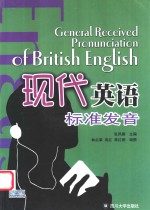

现代英语标准发音PDF电子书下载
- 电子书积分:11 积分如何计算积分?
- 作 者:张凤桐主编;林必果,高红,蒋红柳编撰
- 出 版 社:成都:四川大学出版社
- 出版年份:2004
- ISBN:756142938X
- 页数:294 页
Contents 1
教学提示 1
语调、重音和其他常用符号 1
1 What Is a Good Pronunciation 1
The Gimson Transcription for British General RP 5
吉姆森英语普通型标准发音音标 7
Tone Marks and other Typographical Conventions 7
2 The Model of English Pronunciation 8
2.1 The choice of model 8
2.2 Why should we choose British General RP as our model? 9
2.3 Main differences between the Gimson Transcription and the Jones Transcription 11
3 Two Stages in Learning English Phonemes 14
3.1 Phonemes and their allophones 14
3.2 Two stages in learning English phonemes 16
3.3 Clipping 18
4 Pronouncing Written Words 20
4.1 Letters and sounds 20
4.2 Pronouncing consonant letters c and g 22
4.3 Pronouncing sh,ch and gh 23
4.4 Pronouncing th 23
4.5 Pronunciation,spelling and word stress 24
4.6 Pronouncing single vowel letters 25
4.7 Pronouncing vowel pairs 26
4.8 Silent letters 27
5 The Lungs and the Larynx 29
5.1 The human speech mechanism 29
5.2 The respiratory system 31
5.3 The phonatory system 32
5.4 Learning to control consciously the action of the vocal folds 34
5.5 Identifying the voiced and voiceless sounds 34
5.6 The linguistic usesof pitch 35
6.1 Articulators in the vocal tract 38
6 The Vocal Tract 38
6.2 Places of articulation 41
6.3 Manners of articulation 44
7 Syllables,Stresses and Ton?c Syllables 48
7.1 Syllables,vowels and consonants 48
7.2 Levels of stress 51
7.3 Tonic syllables 52
7.3.1 Information words and English communication 53
7.3.2 Structure words and English communication 53
7.3.3 Tone-units and tonic stress 54
7.4 Summary 54
8.1 The cardinal vowels 56
8 Front Vowels 56
8.2 Classification of the English vowels 60
8.3 Front vowels 61
9 Central Vowels and Back Vowels 71
9.1 Central vowels 71
9.2 Back vowels 77
10 Diphthongs 89
10.1 Closing diphthongs 89
10.2 Centring diphthongs 101
11.1 The English consonant system 107
11 Obstruents(1) 107
11.2 Plosives 109
11.2.1 Bilabial plosives/p,b/ 110
11.2.2 Alveolar plosives/t,d/ 111
11.2.3 Velar plosives/k,g/ 111
11.3 Affricates 114
11.3.1 Palato-alveolar affricates/t∫,d?/ 115
12 Obstruents(2) 117
12.1 Fricatives 117
12.2 Labio-dental fricatives/f,v/ 117
12.3 Dental fricatives/θ,?/ 119
12.4 Alveolar fricatives/s,z/ 122
12.5 Palato-alveolar fricatives/∫,?/ 125
12.6 Glottal fricative/h/ 127
13 Sonorants 129
13.1 Nasals/m,n,?/ 129
13.1.1 Bilabial nasal/m/ 129
13.1.2 Alveolar nasal/n/ 130
13.1.3 Velar nasal/?/ 132
13.2 Alveolar lateral approximant/l/ 134
13.3 Approximants 136
13.3.1 Post-alveolar approximant/r/ 137
13.3.2 Palatal approximant/j/ 140
13.3.3 Labial-velar approximant/w/ 142
14.1.1 Syllable onsets 145
14 The English Syllable 145
14.1 The structure of the English syllable 145
14.1.2 Syllable codas 149
14.2 The-s inflectional ending 150
14.3 The-ed inflectional ending 151
14.4 Syllabification 152
15 Word Stress Patterns 156
15.1 Stress and prominence 156
15.2 Primary and secondary stress 157
15.3 Word stress patterns 158
15.4 Compound words 159
15.5 Word-class pairs 161
16 Weak Forms and Rhythm 163
16.1 Weak forms 163
16.1.1 Conjunctions 163
16.1.2 Pronouns 164
16.1.3 Verbs 164
16.1.4 Determiners 166
16.1.5 Prepositions 166
16.1.6 There 167
16.2 Contracted forms 167
16.3 The use of strong forms 167
16.4 Rhythm and stress 169
17 The Intonation Mark System 173
17.1 A transcribed text 173
17.2 What is intonation? 176
17.3 Tone-unit components 177
17.4 Reading the intonation marks 179
17.4.1 Nuclear tone marks 179
17.4.2 Stress marks in the tail 181
17.4.3 Stress marks in the head 182
18 Functions of Intonation 185
18.1 The organization of information 185
18.2 The realization of communicative functions 186
18.3 The demonstration of syntactic structures 188
18.4 The expression of attitude 191
18.4.1 Major declaratives 191
18.4.2 Minor declaratives 193
18.4.3 Wh-interrogatives 193
18.4.4 Yes/No interrogatives 194
18.4.5 Tag interrogatives 194
18.4.6 Imperatives 195
18.4.7 Exclamatives 195
19.1.1 CC consonant clusters 197
19.1 Clusters in the onset 197
19 Consonant Clusters 197
19.1.2 CCC consonant clusters 200
19.2 Clusters in the coda 201
19.2.1 Stop+stop 201
19.2.2 Plosive+nasal 203
19.2.3 /t/or/d/+/l/ 204
19.2.4 Consonant+/s,z,t,d/ 205
19.2.5 Consonant+/θ/or/?/ 206
19.2.6 /1/+consonant 207
19.2.7 Nasal+consonant 207
19.2.8 Longer consonant clusters at word boundaries 207
20.1 Assimilation 209
20 Natural Processes 209
20.2 Elision 212
20.3 Liaison 214
20.4 Juncture 217
21 English Prosody(1) 219
21.1 Chinese prosody 219
21.2 English prosody 220
21.3 Iambic verse 221
21.4 Anapaestic verse 223
21.5 Trochaic verse 224
21.6 Dactylic verse 225
21.7 Variation in rhythm 226
21.8 Truncation 227
21.9 Mixed substitution 228
21.10 Less commonly used feet 229
21.11 Run-on verse 231
21.12 Caesura 232
22 English Prosody(2) 234
22.1 Rhyme 234
22.2 Definition of rhyme 234
22.3 Masculine rhyme 235
22.4 Feminine rhyme 236
22.6 The leonine 237
22.5 Internal rhyme 237
22.7 Assonance 238
22.8 Consonance 238
22.9 Alliteration 239
22.10 Rhyme scheme 241
22.10.1 Stanzaic verse 241
22.10.2 The septet 242
22.10.3 Triplet 243
22.10.4 The quintet 245
22.10.5 The sestet 246
22.10.6 The octave 246
22.10.7 The Spenserian stanza 248
22.10.8 The sonnet 249
23 Teaching Methods 256
23.1 Vowels 256
23.2 Consonants 257
23.3 Syllables 260
23.4 Word stress 261
23.5 Intonation 262
23.6 Adjustments in connected speech 263
23.7 Using the pronouncing dictionaries 265
Answers Section 268
References 291
- 《大学英语四级考试全真试题 标准模拟 四级》汪开虎主编 2012
- 《全国学前教育专业(新课程标准)“十三五”规划教材 简谱手风琴教程 第2版》(中国)杨克勤,王宝庆 2019
- 《AutoCAD 2018自学视频教程 标准版 中文版》CAD/CAM/CAE技术联盟 2019
- 《HSK标准教程 4 上 练习册》姜丽萍主编 2015
- 《标准急救护理速查手册 普及版》美国骨科医师协会 (AAOS) ,美国急诊医师学会 (ACEP) 主编 2018
- 《全国学前教育专业(新课程标准)“十三五”规划教材 硬笔楷书书写训练 图解版》梅军 2019
- 《弦乐队标准化训练教程 1 教师用书》常林编 2014
- 《Dreamweaver CC 2018标准实例教程 中文版》杨雪静,胡仁喜编著 2019
- 《全国学前教育专业(新课程标准)“十三五”规划教材系列 幼儿园创意美术主题活动方案 上学期》程沿彤 2017
- 《新课程标准“十三五”规划教材系列 学前英语教学参考书 第1册 第2版》姚丹 2019
- 《高考快速作文指导》张吉武,鲍志伸主编 2002
- 《建筑施工企业统计》杨淑芝主编 2008
- 《钒产业技术及应用》高峰,彭清静,华骏主编 2019
- 《燕堂夜话》蒋忠和著 2019
- 《近代旅游指南汇刊二编 16》王强主编 2017
- 《汉语词汇知识与习得研究》邢红兵主编 2019
- 《黄遵宪集 4》陈铮主编 2019
- 《孙诒让集 1》丁进主编 2016
- 《近代世界史文献丛编 19》王强主编 2017
- 《激光加工实训技能指导理实一体化教程 下》王秀军,徐永红主编;刘波,刘克生副主编 2017
- 《大学计算机实验指导及习题解答》曹成志,宋长龙 2019
- 《大学生心理健康与人生发展》王琳责任编辑;(中国)肖宇 2019
- 《大学英语四级考试全真试题 标准模拟 四级》汪开虎主编 2012
- 《大学英语教学的跨文化交际视角研究与创新发展》许丽云,刘枫,尚利明著 2020
- 《复旦大学新闻学院教授学术丛书 新闻实务随想录》刘海贵 2019
- 《大学英语综合教程 1》王佃春,骆敏主编 2015
- 《大学物理简明教程 下 第2版》施卫主编 2020
- 《大学化学实验》李爱勤,侯学会主编 2016
- 《中国十大出版家》王震,贺越明著 1991
- 《近代民营出版机构的英语函授教育 以“商务、中华、开明”函授学校为个案 1915年-1946年版》丁伟 2017
